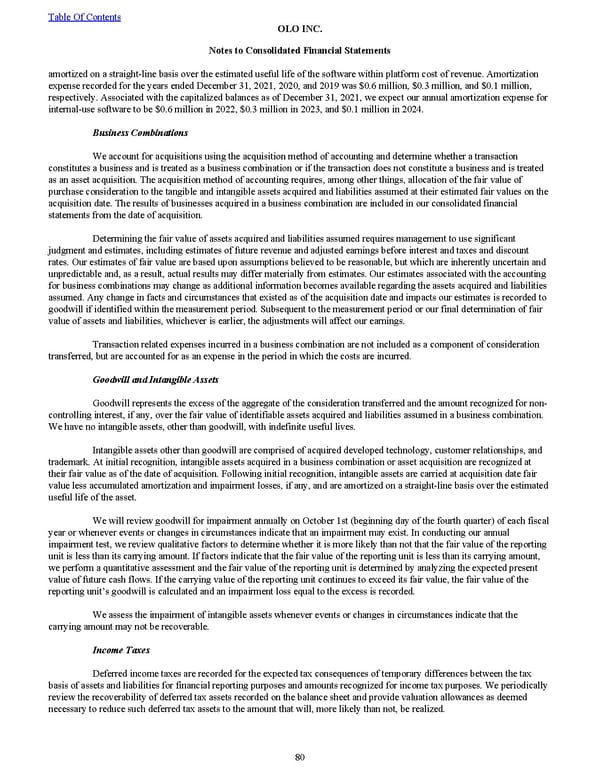amortized on a straight-line basis over the estimated useful life of the software within platform cost of revenue. Amortization expense recorded for the years ended December 31, 2021 , 2020 , and 2019 was $0.6 million , $0.3 million , and $0.1 million , respectively. Associated with the capitalized balances as of December 31, 2021 , we expect our annual amortization expense for internal-use software to be $0.6 million in 2022 , $0.3 million in 2023 , and $0.1 million in 2024 . Business Combinations We account for acquisitions using the acquisition method of accounting and determine whether a transaction constitutes a business and is treated as a business combination or if the transaction does not constitute a business and is treated as an asset acquisition. The acquisition method of accounting requires, among other things, allocation of the fair value of purchase consideration to the tangible and intangible assets acquired and liabilities assumed at their estimated fair values on the acquisition date. The results of businesses acquired in a business combination are included in our consolidated financial statements from the date of acquisition. Determining the fair value of assets acquired and liabilities assumed requires management to use significant judgment and estimates, including estimates of future revenue and adjusted earnings before interest and taxes and discount rates. Our estimates of fair value are based upon assumptions believed to be reasonable, but which are inherently uncertain and unpredictable and, as a result, actual results may differ materially from estimates. Our estimates associated with the accounting for business combinations may change as additional information becomes available regarding the assets acquired and liabilities assumed. Any change in facts and circumstances that existed as of the acquisition date and impacts our estimates is recorded to goodwill if identified within the measurement period. Subsequent to the measurement period or our final determination of fair value of assets and liabilities, whichever is earlier, the adjustments will affect our earnings. Transaction related expenses incurred in a business combination are not included as a component of consideration transferred, but are accounted for as an expense in the period in which the costs are incurred. Goodwill and Intangible Assets Goodwill represents the excess of the aggregate of the consideration transferred and the amount recognized for non- controlling interest, if any, over the fair value of identifiable assets acquired and liabilities assumed in a business combination. We have no intangible assets, other than goodwill, with indefinite useful lives. Intangible assets other than goodwill are comprised of acquired developed technology, customer relationships, and trademark. At initial recognition, intangible assets acquired in a business combination or asset acquisition are recognized at their fair value as of the date of acquisition. Following initial recognition, intangible assets are carried at acquisition date fair value less accumulated amortization and impairment losses, if any, and are amortized on a straight-line basis over the estimated useful life of the asset. We will review goodwill for impairment annually on October 1st (beginning day of the fourth quarter) of each fiscal year or whenever events or changes in circumstances indicate that an impairment may exist. In conducting our annual impairment test, we review qualitative factors to determine whether it is more likely than not that the fair value of the reporting unit is less than its carrying amount. If factors indicate that the fair value of the reporting unit is less than its carrying amount, we perform a quantitative assessment and the fair value of the reporting unit is determined by analyzing the expected present value of future cash flows. If the carrying value of the reporting unit continues to exceed its fair value, the fair value of the reporting unit’s goodwill is calculated and an impairment loss equal to the excess is recorded. We assess the impairment of intangible assets whenever events or changes in circumstances indicate that the carrying amount may not be recoverable. Income Taxes Deferred income taxes are recorded for the expected tax consequences of temporary differences between the tax basis of assets and liabilities for financial reporting purposes and amounts recognized for income tax purposes. We periodically review the recoverability of deferred tax assets recorded on the balance sheet and provide valuation allowances as deemed necessary to reduce such deferred tax assets to the amount that will, more likely than not, be realized. Table Of Contents OLO INC. Notes to Consolidated Financial Statements 80
 2022 10K Page 86 Page 88
2022 10K Page 86 Page 88